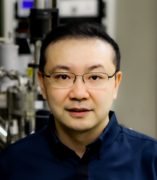
Nan Jiang
Associate Professor
Contact
Address:
4344 SES, MC 111
Office Phone:
Email:
Related Sites:
About
Our group focuses on applying scanning probe-based nanotechnology in nanomaterials design and properties investigation. We are developing a hybrid analytical technique, which combines nanoimaging and nanospectroscopy, to harvest the angstrom resolution topographic information and chemical information with unprecedented spatial and spectroscopic resolution (< 1 nm and < 10 cm-1). We are interested in fundamental science and applications at the angstrom-scale, including charge transfer, electron localization and generation, photoabsorption, and photoemission. Our goal is to provide the capability to dynamically study chemical systems at the single-molecule level and visualize electronic and vibrational effects with sub-molecular resolution.
Body

Body
Probing chemistry of surface-supported nanostructure at the angstrom-scale
The design and fabrication of well-defined molecular nanostructures at solid surfaces is highly attractive for a variety of applications ranging from molecular optics and electronics to chemical sensors. To achieve this goal, we use molecular self-assembly, a powerful bottom-up approach for fabricating molecular nanostructures. The ordering of molecules on a substrate is governed by the interplay of intermolecular and interfacial interactions. We directly probe these nanocontacts using scanning tunneling microscopy (STM) and tip-enhanced Raman spectroscopy (TERS). With specifically chosen molecular units, the functionality of the overall nanostructure can be finely manipulated, which allows us to design and perfect atom- and energy-efficient fabrication of revolutionary new materials with tailored properties.
Determining the mechanism of chemical bond formation under various local environments
The catalysts and supports span a range of shapes and sizes. They feature a variety of surface defects and a great deal of crystallographic inhomogeneity. Catalysis involves chemical transformations that must be understood at the atomic scale since catalytic reactions present an intricate process of chemical bond-breaking and bond-forming steps on only a few isolated sites. The development of next-generation catalysts relies on defining and understanding the sites on the catalyst surface which are most responsible for their useful behavior. We aim to characterize active surface sites with single chemical bond sensitivity, which can correlate the local structure and function of catalysts.
Investigating interface of 2D materials and heterostructures at the atomic scale.
The study of quantum science involves diverse fields including physics, chemistry, and materials science. The discovery of new quantum materials and the understanding of quantum phenomena benefit from the improvements in experimental techniques. Therein, the combination of high spatial, energy, and chemical resolutions provided by state-of-the-art methods is highly desired to reveal unprecedented details of the quantum behaviors involving charge, spin, valley, lattice, and other degrees of freedom. We aim to achieve quantitative measurements of interfacial interaction at the angstrom scale and unveil many details regarding local interactions between these 2D monolayers. These will lay the groundwork for designing a new platform for realizing quantum devices.
See our research on Youtube.
Selected Publications
- L. Li, J. F. Schultz, S. Mahapatra, Z. Lu, X. Zhang, N. Jiang, “Chemically identifying single adatoms with single-bond sensitivity during oxidation reactions of borophene”, Nature Communications, 13, 1796 (1-9), 2022, https://doi.org/10.1038/s41467-022-29445-8.
- S. Mahapatra, J.F. Schultz, L. Li, X. Zhang, N. Jiang, “Controlling Localized Plasmons via an Atomistic Approach: Attainment of Site-Selective Activation inside a Single Molecule”, Journal of the American Chemical Society, 144, 5, 2051-2055, 2022, https://doi.org/10.1021/jacs.1c11547. [Cover] [C&EN News Article]
- H.-T. Zhang, T. J. Park, A. N. M. N. Islam, D. S. J. Tran, S. Manna, Q. Wang, S. Mondal, H. Yu, S. Banik, S. Cheng, H. Zhou, S. Gamage, S. Mahapatra, Y. Zhu, Y. Abate, N. Jiang, S. K. R. S. Sankaranarayanan, A. Sengupta, C. Teuscher, and S. Ramanathan, “Reconfigurable perovskite nickelate electronics for artificial intelligence”, Science, 375, 6580, 533-539, 2022, https://doi.org/10.1126/science.abj7943.
- L. Li, J. F. Schultz, S. Mahapatra, X. Zhang. X. Liu, C. Shaw, M. Hersam, N. Jiang, “Probing interfacial interactions in an organic/borophene heterostructure with angstrom resolution”, Journal of the American Chemical Society, 143, 38, 15624-15634, 2021, https://doi.org/10.1021/jacs.1c04380. [Cover]
- L. Li, N. Jiang, “Proximity and single-molecule energetics”, Science, 373, 392-393, 2021, https://doi.org/10.1126/science.abj5860.
- L. Li, S. Mahapatra, D. Liu, Z. Lu, N. Jiang*, “On-Surface reaction with single molecule resolution: Progress, Challenges, and Opportunities”, ACS Nano, 15, 3578-3585, 2021, https://doi.org/10.1021/acsnano.0c08148.
- S. Mahapatra, L. Li, J. F. Schultz, N. Jiang, “Tip-Enhanced Raman Spectroscopy: Chemical Analysis from Nanoscale to Angstrom Scale”, The Journal of Chemical Physics, 153, 010902, 2020, https://doi.org/10.1063/5.0009766. [Editor’ Choice Award] [Cover]
- J. F. Schultz, L. Li, S. Mahapatra, C. Shaw, X. Zhang, N. Jiang, “Defining Multiple Configurations of Rubrene on a Ag(100) Surface with 5 Angstrom Spatial Resolution via Ultrahigh Vacuum Tip-Enhanced Raman Spectroscopy”, The Journal of Physical Chemistry C, 124, 2420-2426, 2020, https://doi.org/10.1021/acs.jpcc.9b09162. [Cover]
- S. Mahapatra, Y. Ning, J. F. Schultz, L. Li, J. -L. Zhang, N. Jiang, “Angstrom Scale Chemical Analysis of Metal Supported Trans- and Cis-Regioisomers by Ultrahigh Vacuum Tip-Enhanced Raman Mapping”, Nano Letters, 19, 3267-3272, 2019, https://doi.org/10.1021/acs.nanolett.9b00826.
- N. Jiang, N. Chiang, L. R. Madison, E. A. Pozzi, M. R. Wasielewski, T. Seideman, M. A. Ratner, M. C. Hersam, G. C. Schatz, R. P. Van Duyne, “Nanoscale Chemical Imaging of a Dynamic Molecular Phase Boundary with Ultrahigh Vacuum Tip-Enhanced Raman Spectroscopy”, Nano Letters, 16, 3898-3904, 2016, https://doi.org/10.1021/acs.nanolett.6b01405.
- N. Jiang, E. T. Foley, J. M. Klingsporn, M. D. Sonntag, N. A. Valley, J. A. Dieringer, T. Seideman, G. C. Schatz, M. C. Hersam, R. P. Van Duyne, “Observation of Multiple Vibrational Modes in Ultrahigh Vacuum Tip-Enhanced Raman Spectroscopy Combined with Molecular-Resolution Scanning Tunneling Microscopy”, Nano Letters, 12, 5061-5067, 2012, https://doi.org/10.1021/nl2039925. [Cover]
- N. Jiang, Y. Y. Zhang, Q. Liu, Z. H. Cheng, Z. T. Deng, S. X. Du, H.-J. Gao, M. J. Beck, S. T. Pantelides, “Diffusivity control in molecule-on-metal systems using electric fields”, Nano Letters, 10, 1184-1188, 2010, https://doi.org/10.1021/nl903473p.
About
Education
BS, University of Science and Technology of China, 2004
PhD, Chinese Academy of Sciences, 2010
Joint PhD student, Max Planck Institute for Solid State Research, 2008-2009
Postdoctoral Fellow, Northwestern University, 2010-2015.